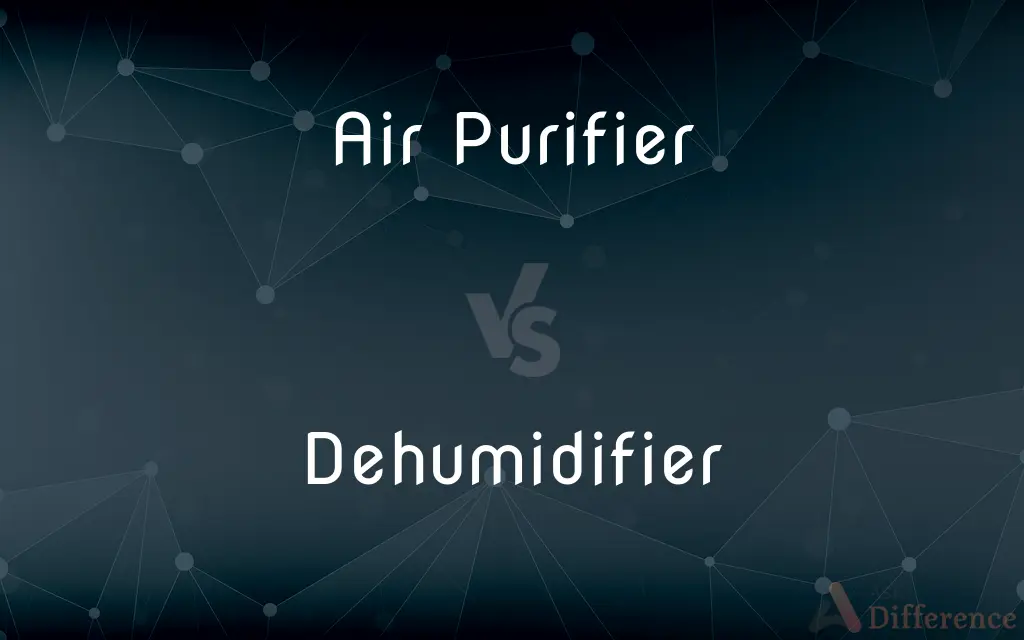Air Purifier vs. Dehumidifier — What's the Difference?
Edited by Tayyaba Rehman — By Fiza Rafique — Published on November 11, 2023
An Air Purifier cleans the air of pollutants; a Dehumidifier reduces moisture levels. Both improve indoor air quality.

Difference Between Air Purifier and Dehumidifier
Table of Contents
ADVERTISEMENT
Key Differences
Air Purifiers and Dehumidifiers serve different primary purposes within indoor environments. An Air Purifier is designed to remove airborne contaminants such as dust, pollen, and allergens. It uses filters, and sometimes additional technologies, to cleanse the air. Conversely, a Dehumidifier is intended to lower the humidity level in a room by extracting excess moisture from the air.
Air Purifiers function by drawing in room air and passing it through a series of filters, capturing particles. This process aids in reducing allergens, pollutants, and even odors. Dehumidifiers, on the other hand, work by cooling air to condense its moisture content, collecting the resultant water in a tank, thereby reducing the humidity level.
The need for an Air Purifier often arises in situations where residents experience allergies, or there's a presence of smoke or pet dander. They help in maintaining a healthier indoor atmosphere. Dehumidifiers are essential in damp environments or places where mold growth is a concern, as they maintain a balanced humidity level, preventing mold and mildew.
Both Air Purifiers and Dehumidifiers play a role in enhancing the comfort of living spaces. An Air Purifier can reduce symptoms for allergy sufferers, and aid in better respiratory health. A Dehumidifier, by controlling moisture levels, can prevent structural damage to homes and provide relief in overly humid conditions.
To conclude, while both Air Purifiers and Dehumidifiers address indoor air quality, their primary functions differ. Air Purifiers focus on eliminating airborne particles, while Dehumidifiers control moisture to prevent excess humidity and its associated problems.
ADVERTISEMENT
Comparison Chart
Primary Function
Removes airborne contaminants.
Reduces room's humidity level.
Mechanism
Uses filters to cleanse air.
Cools air to condense moisture.
Health Benefits
Reduces allergens, pollutants, and odors.
Prevents mold growth and reduces dampness.
Typical Use Case
Allergy relief, smoke and odor removal.
Damp environments, mold prevention.
Maintenance
Requires filter changes/cleaning.
Often needs tank emptying or continuous drainage.
Compare with Definitions
Air Purifier
A device that removes contaminants from indoor air.
She bought an Air Purifier to reduce her allergy symptoms.
Dehumidifier
A device that reduces ambient moisture levels.
The basement felt less damp after using the Dehumidifier.
Air Purifier
An apparatus aiding in better respiratory health indoors.
With the Air Purifier running, he noticed fewer asthma triggers.
Dehumidifier
An appliance extracting water from air to control humidity.
To combat mold growth, they placed a Dehumidifier in the bathroom.
Air Purifier
An appliance that filters airborne particles.
The Air Purifier was effective in removing the pet dander.
Dehumidifier
An apparatus that collects condensed water from the air.
The Dehumidifier's tank needed emptying after a particularly humid day.
Air Purifier
A machine designed to capture pollutants like pollen, smoke, and dust.
After the wildfires, many residents invested in Air Purifiers.
Dehumidifier
A tool aiding in maintaining balanced indoor humidity.
The Dehumidifier made the summer months more bearable inside the house.
Air Purifier
A tool used to enhance indoor air quality.
Since getting an Air Purifier, the room smelled fresher and felt cleaner.
Dehumidifier
A machine preventing excessive moisture and resultant mold.
After noticing water damage, she immediately bought a Dehumidifier.
Dehumidifier
To remove atmospheric moisture from.
Dehumidifier
A device for removing the moisture content from air
Common Curiosities
How often should Air Purifier filters be replaced?
It varies by model and use but typically every 6-12 months.
Does a Dehumidifier purify the air?
While a Dehumidifier's primary function is moisture control, it indirectly improves air quality by preventing mold growth.
What's the main function of an Air Purifier?
An Air Purifier cleans indoor air by removing contaminants like pollen, dust, and allergens.
Do Dehumidifiers produce heat?
Some heat is generated during the dehumidifying process, but it's typically minimal.
Why would one use a Dehumidifier?
A Dehumidifier is used to lower excess humidity in a space, preventing dampness and mold.
How do you maintain a Dehumidifier?
Regularly empty its water tank, clean filters, and ensure proper airflow.
Do all Air Purifiers remove viruses?
Not all, but certain Air Purifiers with HEPA or UV technology can capture or neutralize viruses.
Can an Air Purifier remove odors?
Yes, many Air Purifiers can reduce or eliminate odors, especially those with activated carbon filters.
Do Air Purifiers use a lot of electricity?
Most modern Air Purifiers are energy efficient, but usage depends on size and operation frequency.
Is a Dehumidifier useful for allergy sufferers?
Yes, by reducing humidity, Dehumidifiers can help minimize mold and dust mites, common allergens.
Can Air Purifiers help with smoke?
Yes, Air Purifiers with HEPA and activated carbon filters are effective at smoke removal.
Are there combined Air Purifier and Dehumidifier units?
Yes, some models combine both functions for comprehensive air quality improvement.
Should Dehumidifiers run continuously?
Depending on the humidity level, some may benefit from continuous operation, while others use built-in hygrometers to determine operation needs.
Where's the best place to position a Dehumidifier?
In areas with high humidity, like basements, bathrooms, or laundry rooms.
Can Air Purifiers and Dehumidifiers run simultaneously?
Yes, they can operate together for improved air quality and comfort.
Share Your Discovery

Previous Comparison
Fiber vs. Probiotics
Next Comparison
Database vs. WebsiteAuthor Spotlight
Written by
Fiza RafiqueFiza Rafique is a skilled content writer at AskDifference.com, where she meticulously refines and enhances written pieces. Drawing from her vast editorial expertise, Fiza ensures clarity, accuracy, and precision in every article. Passionate about language, she continually seeks to elevate the quality of content for readers worldwide.
Edited by
Tayyaba RehmanTayyaba Rehman is a distinguished writer, currently serving as a primary contributor to askdifference.com. As a researcher in semantics and etymology, Tayyaba's passion for the complexity of languages and their distinctions has found a perfect home on the platform. Tayyaba delves into the intricacies of language, distinguishing between commonly confused words and phrases, thereby providing clarity for readers worldwide.












































